
Precision Medicine in Head and Neck Cancer

Key takeaways from a paper that evaluated the efficacy of tipifarnib in recurrent and/or metastatic mHRAS head and neck squamous cell carcinoma.
Victoria Meucci Villaflor, MD: Hello, and welcome to the discussion portion of Between the Lines, A Journal Club Experience. We just reviewed the article “Tipifarnib in Head and Neck Squamous Cell Carcinoma With HRAS Mutations.” We’ll quickly summarize the patient, then discuss the potential implications. Dr Perez, what did you feel were some key takeaways from this paper?
Cesar Perez, MD: It’s a small trial, but it’s clinically significant for small populations of patients with head and neck cancer. As a head and neck oncologist, this is obviously quite an exciting finding. The fact that a drug 20 years in the making achieves a strong benefit when selecting the right population is potentially a success story. We’ve always been hearing many success stories of developing agents for patients in the lung cancer arena but very few in the head and neck cancer arena. This gives us much more hope. Hopefully this will eventually translate into a larger story.
Victoria Meucci Villaflor, MD: As both a head and neck and thoracic oncologist, I’ve seen a lot over the past couple of decades. When I look at the era of what people would call precision medicine or personalized medicine, I’ve been lucky in my career to see all this develop. Coming out of my fellowship, all we had was chemotherapy, essentially. Among the first targeted agents were the EGFR drugs, which we were able to use in our world. I remember breast cancer always being lucky. They were ahead of us, whereas we had nothing in the thoracic and head and neck world.
Cetuximab was the first drug that was developed, and Jan Vermorken and James Bonner published in this area. We had targeted treatment for the first time in head and neck cancer in the form of targeting EGFR. That stayed there. In the meantime, 1 cancer took off because we had the tyrosine kinase inhibitors in EGFR, and then you had ELF, RAS1, RET, MET, and all the other targets that we have. Then along came the checkpoint inhibitors with immune function, which was another big finding for head and neck cancer. But we haven’t had this take off.
Even though this is a small trial, it’s a very exciting trial because this is the first trial in which we’re targeting a molecular abnormality. Like the lung cancer series, in which we’ve been targeting all these things—most recently the sister molecule KRAS—we’re able to almost follow the molecular correlates in the tumor and potentially other specimens. In lung cancer, if a patient has an EGFR, like L858R, you can give them osimertinib. With this one, I feel like we’ve been developing this drug for patients who have HRAS mutations, and we’re also looking at the variable allele frequency. It’s very interesting because it’s better at consolidating the patients who we’re most likely to get a response in. That’s very interesting, and I look forward to further development in that area.
Cesar Perez, MD: It’s very important and compelling. The only targeted therapy that we use after JAK1 inhibitors, besides immunotherapy, is cetuximab, and we don’t have a good predictive marker for it. The single-agent response rate is just 10%. It adds to the efficacy of chemotherapy. But truly the only predictive marker we have is PD-L1. That’s not a perfect biomarker. Having these predictive markers for a new agent is a very exciting thing in the cancer world.
Transcript edited for clarity.
Newsletter
Stay up to date on recent advances in the multidisciplinary approach to cancer.





















































































